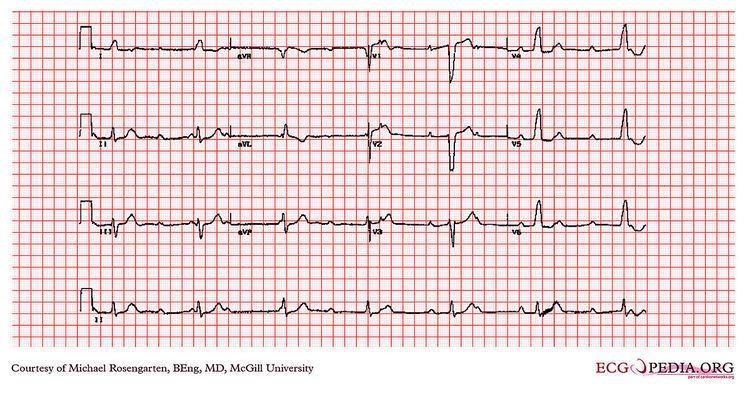ICD-10 R68.89 | ICD-9-CM V47.2 | |
 | ||
Exercise intolerance is a condition of inability or decreased ability to perform physical exercise at what would be considered to be the normally expected level or duration. It also includes experiences of unusually severe post-exercise pain, fatigue, nausea, vomiting or other negative effects. Exercise intolerance is not a disease or syndrome in and of itself, but can result from various disorders.
Contents
- Respiratory disorders
- Chronic fatigue syndrome
- Post concussion syndrome
- Heart conditions
- Musculoskeletal disorders
- Mutations
- Cytochrome b mutations
- Intracranial hypertension
- Treatment
- Hazards
- References
Intolerance to exercise may be caused by unusual breathlessness (dyspnea), muscle pain (myalgia), tachypnoea (abnormally rapid breathing), tachycardia (having a faster heart rate than normal) or increasing muscle weakness; or exercise might result in severe headache, nausea, dizziness, occasional muscle cramps or extreme fatigue, which would make it intolerable.
In most cases, the specific reason that exercise is not tolerated is of considerable significance when trying to isolate the cause down to a specific disease. Dysfunctions involving the pulmonary, cardiovascular or neuromuscular systems have been frequently found to be associated with exercise intolerance, with behavioural causes also playing a part.
Respiratory disorders
Chronic fatigue syndrome
Post-concussion syndrome
Heart conditions
Musculoskeletal disorders
Mutations
Cytochrome b mutations
Cytochrome b mutations can frequently cause isolated exercise intolerance and myopathy and in some cases multisystem disorders. The mitochondrial respiratory chain complex III catalyses electron transfer to cytochrome c. Complex III is embedded in the inner membrane of the mitochondria and consists of 11 subunits. Cytochrome b is encoded by the mitochondrial DNA which differs from all other subunits which are encoded in the nucleus. Cytochrome b plays a major part in the correct fabricating and function of complex III.
This mutation occurred in an 18-year-old man who had experienced exercise intolerance for most of his adolescence. Symptoms included extreme fatigue, nausea, a decline in physical activity ability and myalgia.
Intracranial hypertension
Individuals with elevated levels of cerebrospinal fluid can experience increased head pain, throbbing, pulsatile tinnitus, nausea and vomiting, faintness and weakness and even loss of consciousness after exercise or exertion.
Treatment
Exercise is key for many heart and back patients, and a variety of specific exercise techniques are available for both groups. Some exercise specialists are trained in modifications specific to these patients.
In individuals with heart failure and normal EF (ejection fraction), including aortic distensibility, blood pressure, LV diastolic compliance and skeletal muscle function, aerobic exercise has the potential to improve exercise tolerance. A variety of pharmacological interventions such as verapamil, enalapril, angiotensin receptor antagonism, and aldosterone antagonism could potentially improve exercise tolerance in these individuals as well.
Research on individuals suffering from Chronic obstructive pulmonary disease (COPD), has found a number of effective therapies in relation to exercise intolerance. These include:
- Oxygen Supplementation
- Reduces carotid body drive and slows respiration at a given level of exercise.
- Treatment with bronchodilators
- Clinically useful improvements in expiratory airflow, allows fuller exhalation in a given period of time, reduces dynamic hyperinflation, and prolongs exercise tolerance.
- Heliox (79% Helium, 21% oxygen)
- Heliox has a lower density than air.
- Breathing heliox lowers expiratory airflow resistance, decreases dynamic hyperinflation, and prolongs exercise tolerance.
- High intensity rehabilitative exercise training
- Increasing the fitness of muscles decreases the amount of lactic acid released at any given level of exercise.
- Since lactic acid stimulates respiration, after rehabilitative training exercising, ventilation is lower, respiration is slowed, and dynamic hyperinflation is reduced.
A combination of these therapies (Combined therapies), have shown the potential to improve exercise tolerance as well.
Hazards
Certain conditions in particular exist where exercise, particularly rehabilitation, may be contraindicated, including:
Other conditions may also preclude exercising under certain conditions. Passive physiotherapy can in some instances be an alternative for some patients unable to safely self-power.
